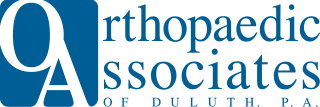Getting You Back In The Game After An ACL Injury
September 12, 2023
If you have ever participated in a high demand sport like football, soccer, basketball or tennis, chances are you know someone or have experienced first hand an ACL or anterior cruciate ligament injury. Read on to learn more about the ACL, recognizing an injury, treatment, and how to avoid injury from the start.
Anatomy and Function of ACL
The knee joint is a complex structure of bones, ligaments, tendons, and other tissues, which all need to work together for healthy movement. The ACL is the tissue (ligaments) that connects the thigh bone (femur) to the shin bone (tibia), crossing over at the knee.

Injuries of the ACL typically happen during sports and fitness activities that put stress on the knee. Movements including pivoting with your foot in place, landing from a jump, suddenly changing direction or stopping, and participating in a collision that causes a direct blow to the knee can cause torn or sprained ligaments.
You may be at increased risk if you are female due to difference in anatomy, hormone influences, and muscle strength. Other risks include having poor movement patterns and conditioning, or using equipment that doesn’t fit or that has not been well maintained.
Recognizing Injury
Most people hear or feel a popping sensation in their knee when experiencing an ACL injury.
While some people may be able to function normally with a torn or sprained ACL, most people experience knee swelling, instability, a limited range of motion, and pain. Leaving an ACL injury untreated can lead to further knee damage and discontinuation of your same level of play.
Seek immediate care from your physician if there are any signs or symptoms of an ACL injury.
Diagnosis and Imaging Techniques
During your appointment, a physician will check your knee for swelling and tenderness. They will also check for range of motion and overall function of the joint. In order to diagnose the severity of the injury, our team may also do imaging which could include X-rays to rule out a bone fracture, MRI to see both the hard and soft tissues, or an ultrasound to check the ligaments, tendons, and muscles.
Treatment Options
Immediately after injury, follow the R.I.C.E. model of self-care to reduce pain and swelling. R.I.C.E. stands for: Rest, Ice, Compression, Elevation.
Depending on the severity of the injury, treatment can range from rest and rehab exercises to surgery. Surgery will replace the torn ligament, followed by rehabilitation.
When it comes to rehabilitation, a physical therapist will teach you exercises to do in-office and at home. You may also wear a brace to stabilize your knee and crutches in order to avoid putting weight on the knee. This course of treatment is successful for those who are relatively inactive.
We may suggest surgery if you are an athlete in an intense sport and want to continue playing, more than one ligament in your knee is injured, or your injury is causing the knee to buckle during daily activities.
During the surgery, your surgeon will remove the damaged ligament and replace it with a graft, or a segment of tendon. This graft will come from another part of your knee or a donor’s knee.
There is no set time frame for recovery, every athlete and injury is different. Your physician and physical therapist will perform assessments to test your knee’s stability, function, and strength to determine readiness to return to sports intermittently throughout your recovery. The goal is to ensure the injury is fully healed before returning, in order to limit the risk of a recurring injury.
Preventative Measures
You can prevent an ACL injury through proper training. Members of our Sports Medicine team provide assessments and offer feedback to help reduce your risk. Practicing techniques to strengthen the muscles of the core, hips, and legs, as well as utilizing jumping and landing techniques that prevent the inward turning of the knee also can go a long way in preventing injury.
Wearing the correct gear and padding will also prevent injury. Make sure all bindings and equipment are adjusted to your needs and working appropriately. With these precautions in place, you will limit the likelihood of an ACL tear.
However, if you do suffer from an injury and need medical attention, you can set up a same day appointment with our team. Learn more about our Sports Medicine services and schedule an appointment: http://oaduluth.com/sports-medicine.php.
